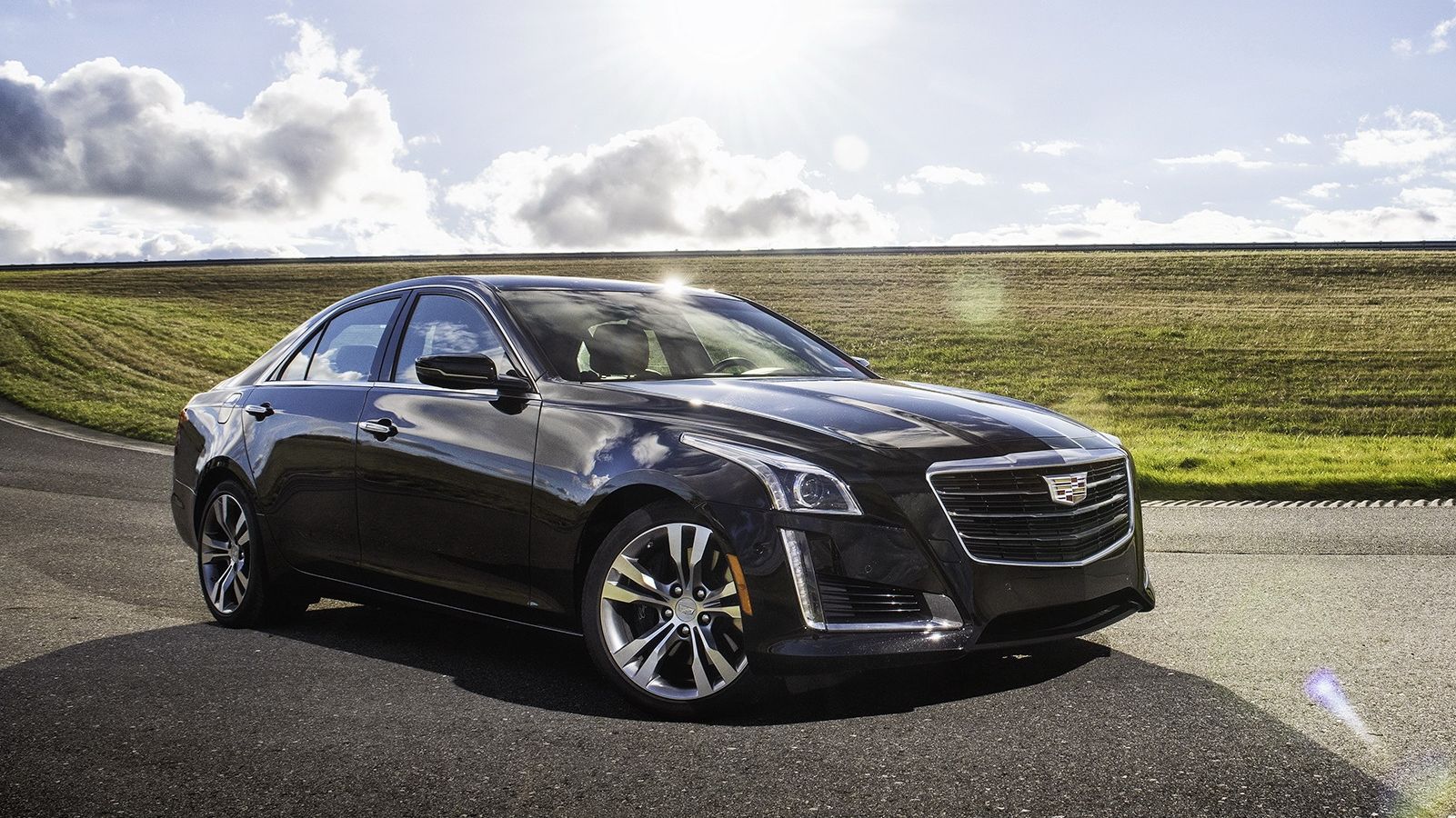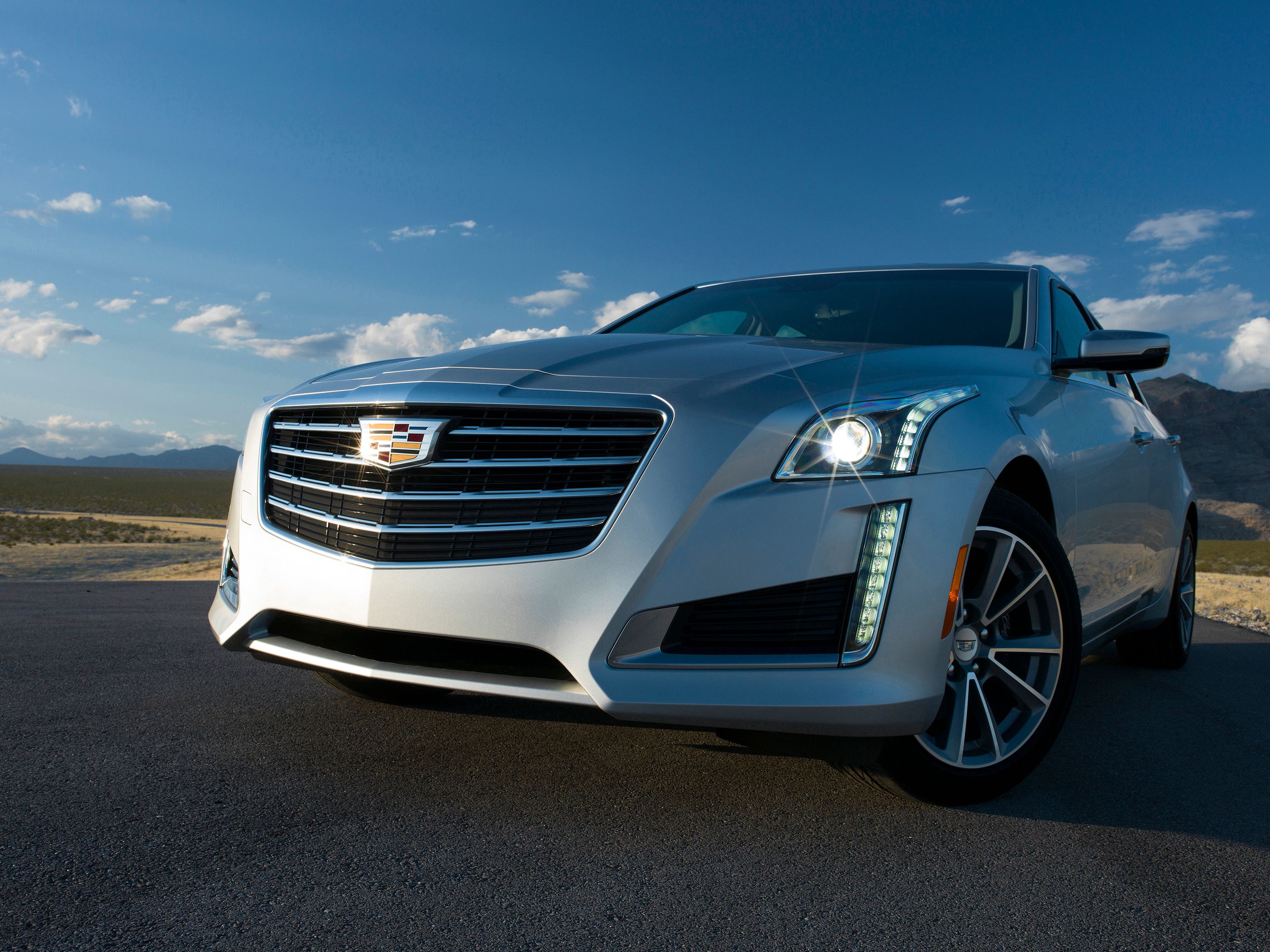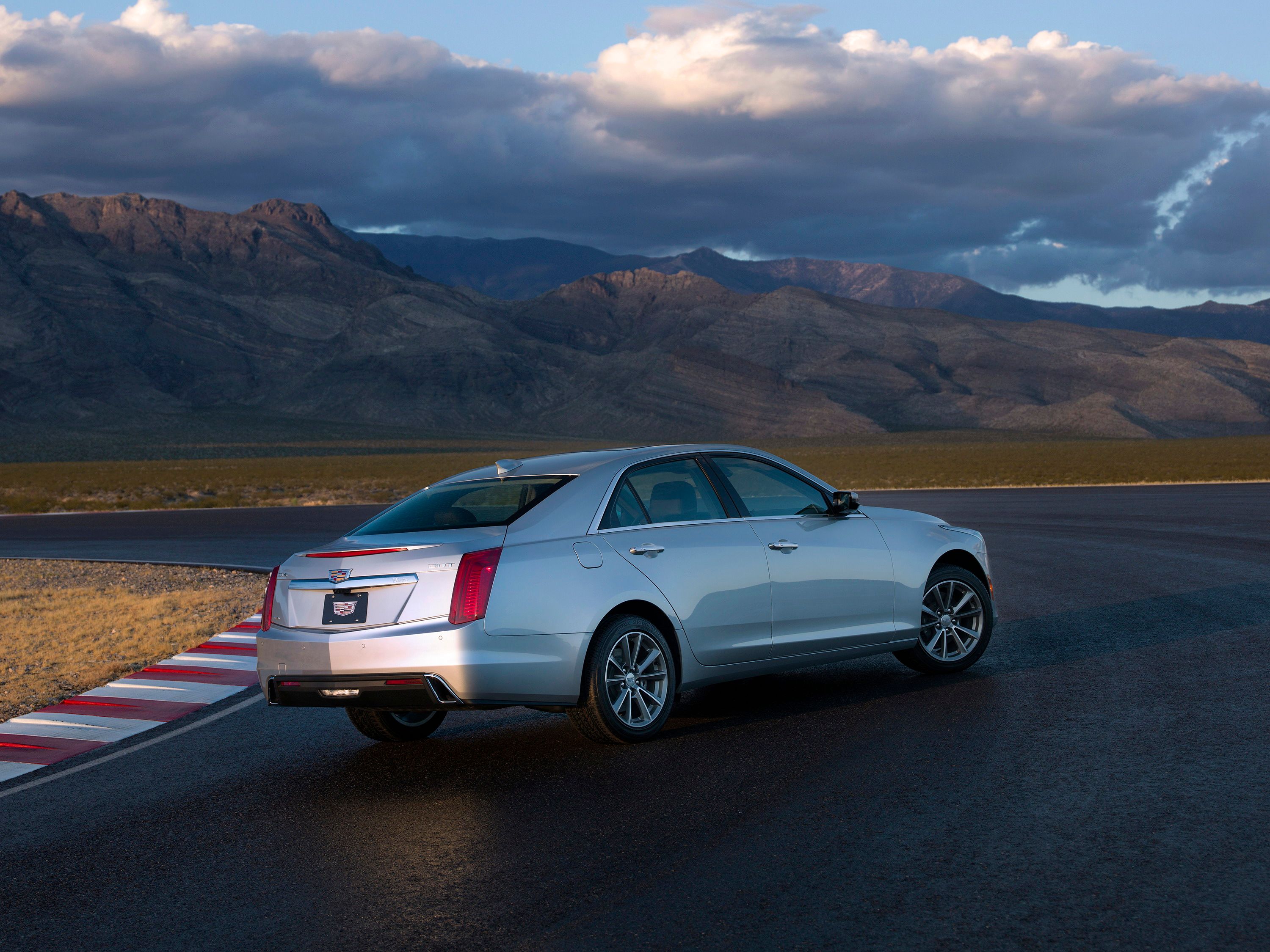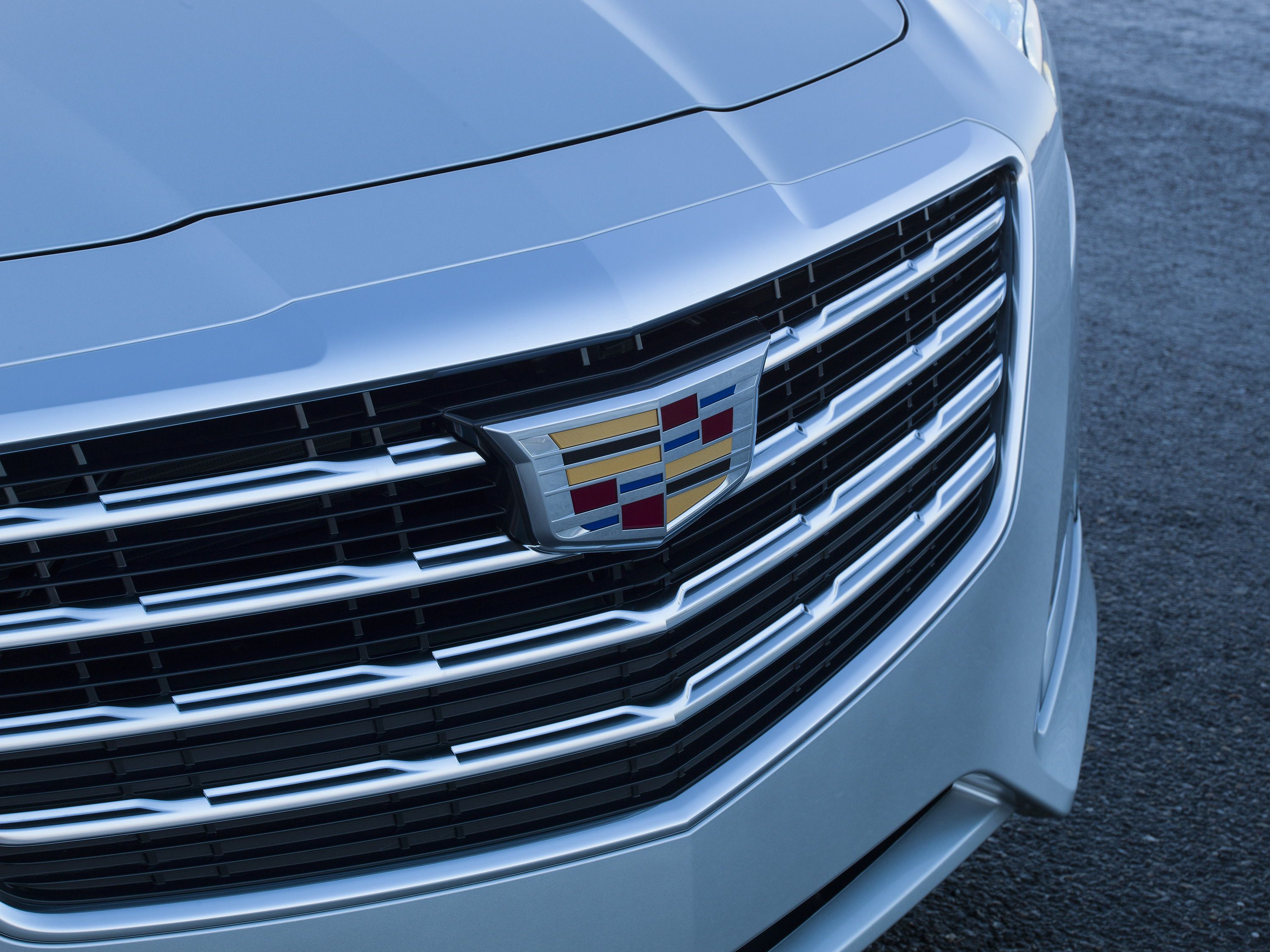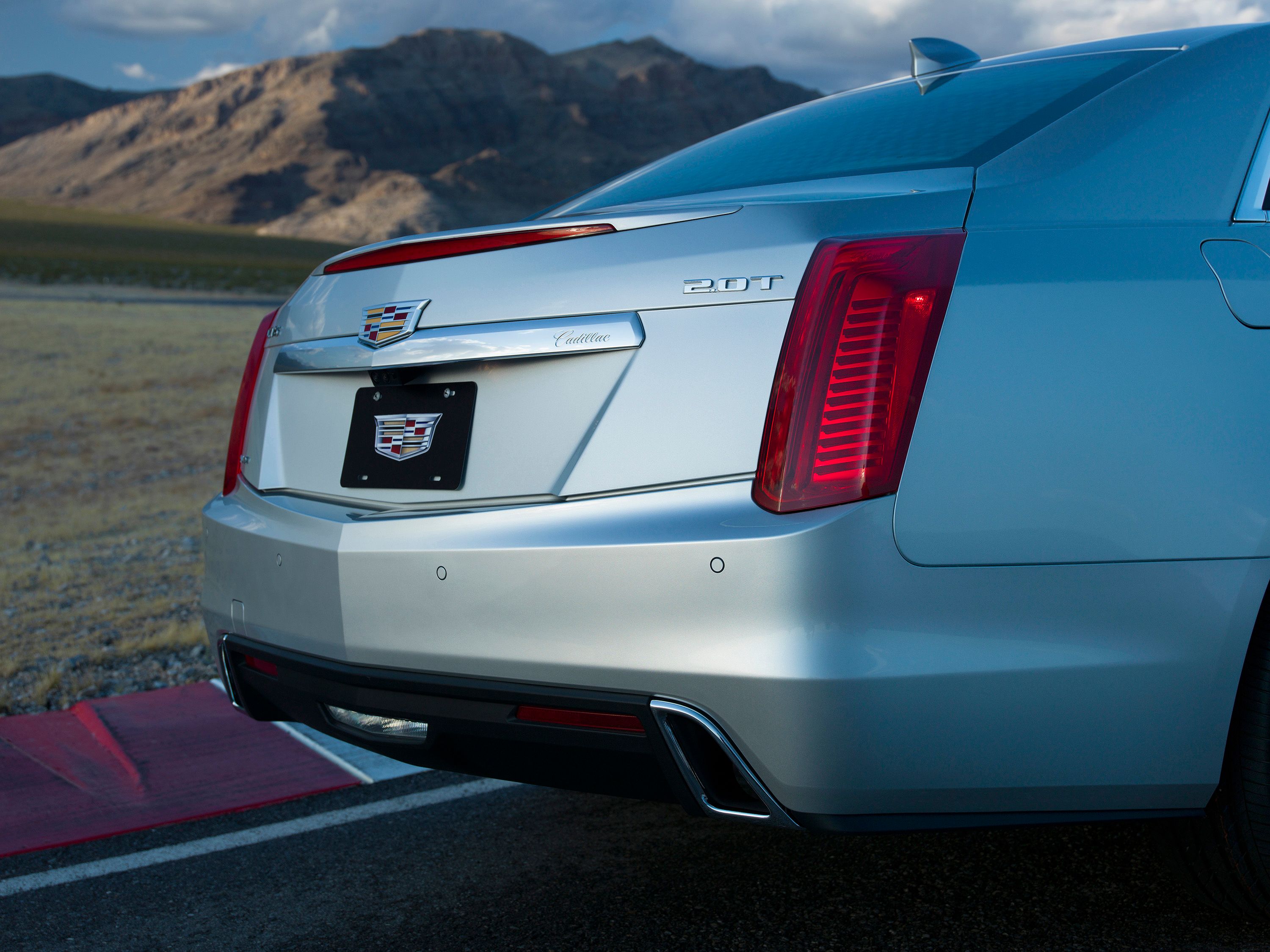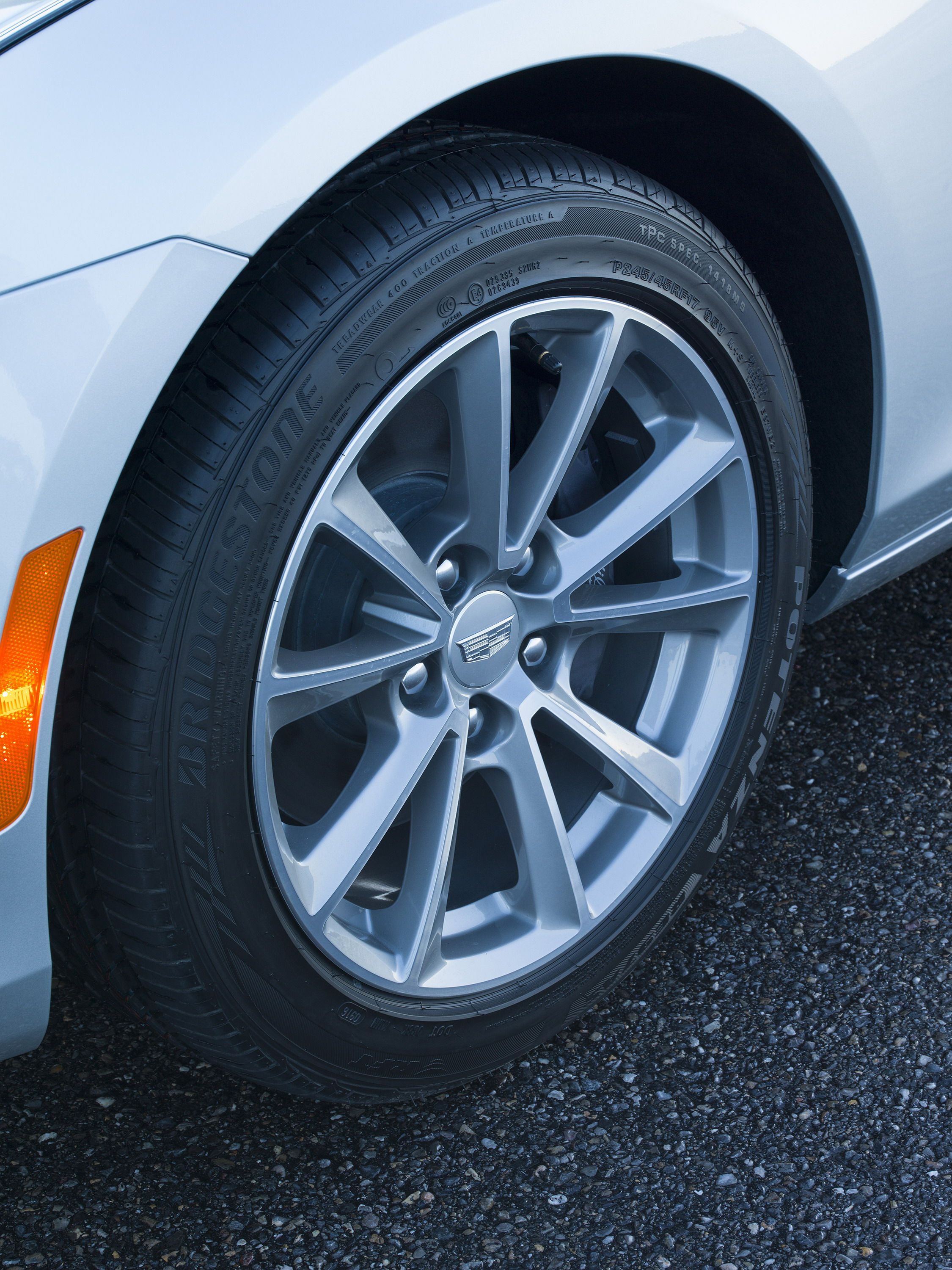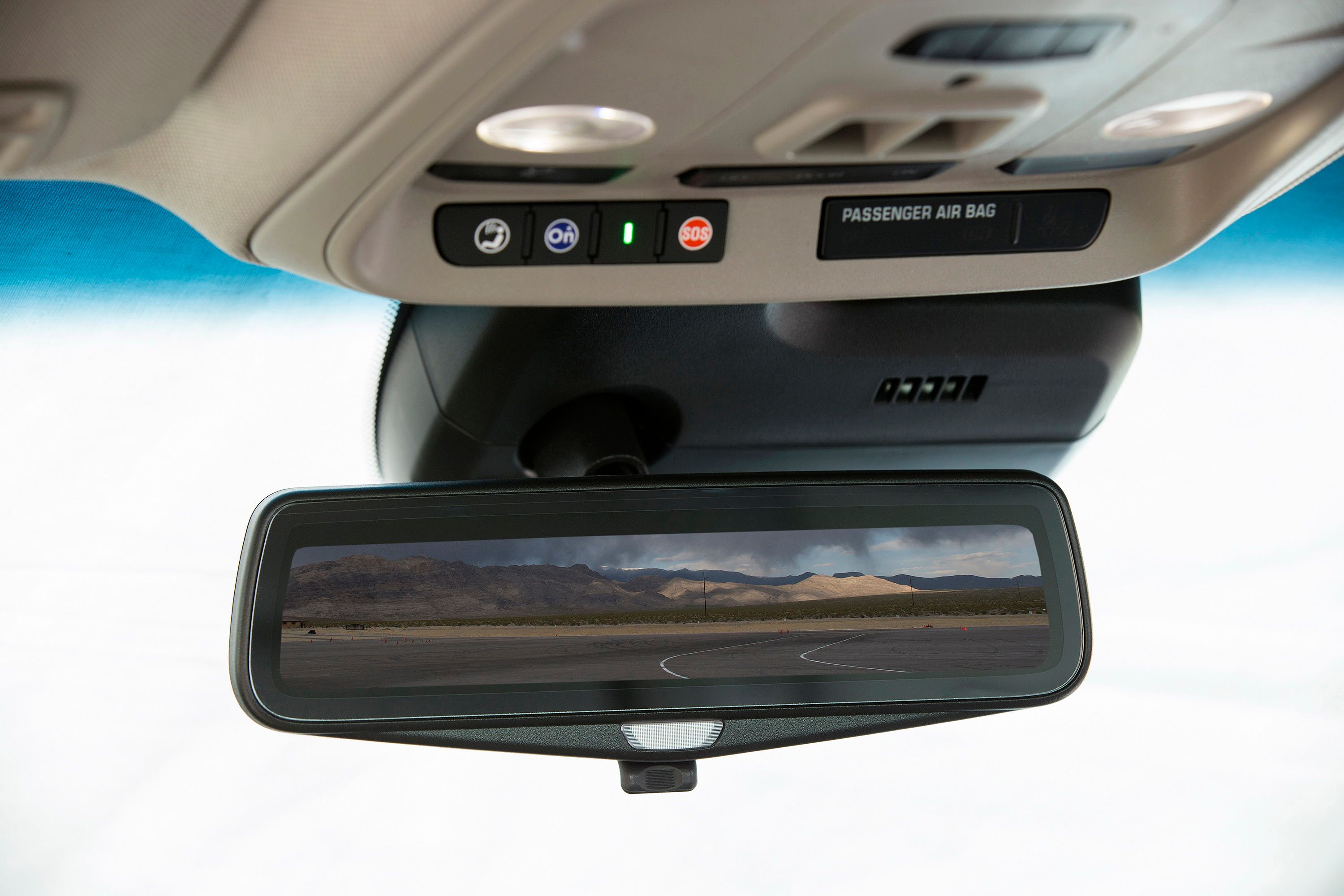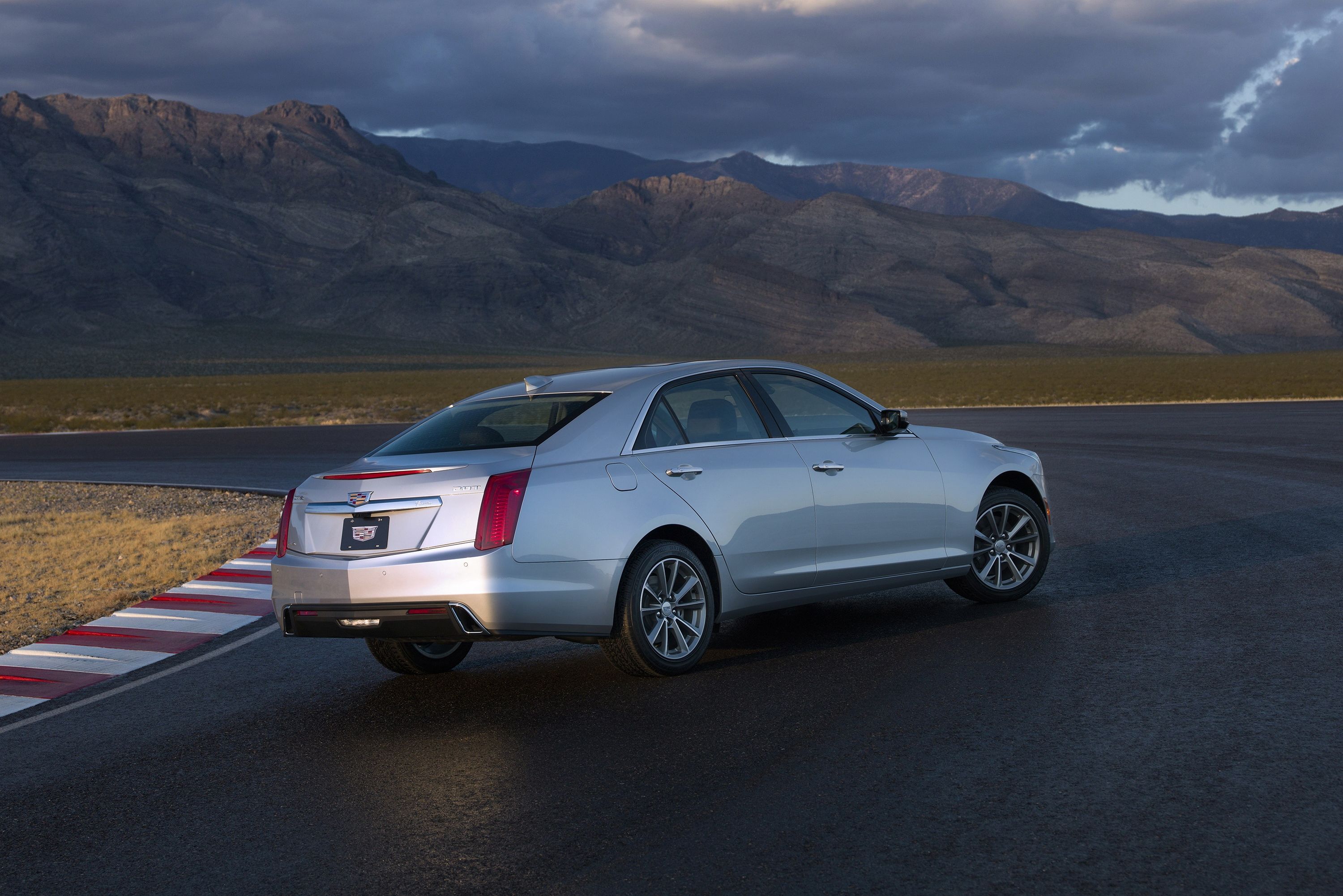The first-generation Cadillac CTS mid-size executive sedan debuted in 2002, heralding the luxury brand’s return to a RWD platform and becoming the first Cadillac model to offer a manual transmission in roughly 15 years. Initially offered as a sedan, the second-generation CTS debuted for the 2008 model year at the 2007 Detroit Auto Show, adding a two-door coupe and a five-door sport wagon body style to the lineup, while also adding width and length to the exterior dimensions. The current third-generation model was revealed in March of 2013, with the coupe and wagon dropped in favor of a sedan body style only. Engine options for the third-gen include a 2.0-liter turbocharged four-cylinder and a 3.6-liter V-6, as well as a new twin-turbo V-6 for the V-Sport model to fill the gap behind the high-performance supercharged CTS-V. Essentially designed to compete head-to-head with popular German rivals like the BMW 5 Series, Audi A6 line, and Mercedes E-Class, the Cadillac CTS mixes opulence and comfort with speed and attitude, tempting buyers with an all-American alternative to the Euro status quo. To keep it fresh, Caddy updated the CTS for the 2017 model year with a slightly revamped exterior look, new interior technology, and a more “streamlined” approach to the various trim grades.
You could call it a mild refresh, with the usual facelift gloss all present and correct. So far, the critics have lauded the CTS for its luxurious cabin and fun factor behind the wheel, with Motor Trend giving the CTS its Car of the Year award in 2014, and Car and Driver awarding the model a spot on its 10 Best list three years running. But customers continue to pass it up in favor of a product from across the pond, which begs the question – is the CTS truly a worthy alternative?
Continue reading to learn more about the 2017 Cadillac CTS.
2017 Cadillac CTS
- Make: Array
- Model: 2017 Cadillac CTS
- [do not use] Vehicle Model: Array
Exterior
When the first-gen CTS was introduced back in 2002, it debuted Cadillac’s new “Art and Science” design language, a look that was initially previewed on the Evoq concept vehicle that dropped at the 1990 Detroit Auto Show. In the 15 years that followed the first-gen CTS, the design has changed slowly but surely, with the 2017 model year representing the latest evolution.
Note: Cadillac Evoq concept car pictured on the left, first-generation Cadillac CTS pictured on the right, and 2017 Cadillac CTS pictured on the bottom.
Taking responsibility for the third-gen design is Robin Krieg and Bob Boniface. The 2017 model year adds to the styling with a new front grille design, as well as a new rear fascia, although the more performance-oriented CTS V-Sport and CTS-V models retain the old front fascia as is.
Regardless, Cadillac says it’s still going for that “long, lean and low” trifecta you’d expect from an entry in this segment. The grille is broad and chromed out, mimicking the shape of the Cadillac crest. The lines in the headlights and side intakes are all hard angles and deep cuts, with very little roundness in the shapes used. The vertical daytime running lights and headlights housings send the eye rearwards along the bulging hoodline, which is neatly plumped through the center like a nod to GM’s muscle car roots.
The profile is chunky and solid, with more hard angles added to the lower character line and window line. The proportions are very much a three-box sort of look, although the C-pillar gets a little extra width that suggests a more coupe-like appearance. The stance is low, with the fenders hugging the large wheels in a determined poise.
In back, the upright design of the headlights is repeated in the taillights and twin trapezoidal exhaust tips. Further horizontal chrome trim can be found on the trunk lid, above which is a slight suggestion of a spoiler. The whole thing is extremely square, finishing what was started in the nose.
Features include a Galvano chrome finish for the grill on the CTS, Luxury, and Premium Luxury trim levels, while black chrome and a different grille design are used to separate out the V-Sport and V-Sport premium Luxury models. Active aero grille shutters, which close to maximize mpg and open to keep the engine cool, are standard equipment on the CTS, Luxury, and Premium Luxury trim levels.
Those characteristic vertical headlights and lower bumper daytime running lights are equipped with LED lighting signatures, forming a neat, straight-line connection with the “light guides” in the housings. Projector headlights with halogen bulbs are offered as standard, while high-intensity discharge (HID) units with an Adaptive Forward Lighting feature are optional.
There’s optional exterior lighting offered for the door handles, plus a Galvano polished aluminum finish for extra bling. Galvano aluminum trim was also used for the window surrounds, which widens towards the rear to enhance the car’s coupe-ness.
In back, we see an updated rear valence housing the chrome finish for the exhaust pipes. The vertical design elements are complemented by LED lighting in the taillights, plus there’s a horizontal rear stop lamp (Caddy calls it an “upper illumination blade”) that helps to visually widen the tail with the recurring chevron shape.
Further options include the Carbon Black Package, which throws on a new Black Chrome finish for the front end, a more aggressive V-Series spoiler for the back end, and an After Midnight dark finish for the wheels.
Speaking of the rollers, the 2017 CTS gets two new looks for the wheels, including a new 17-inch design, as well as a new 18-inch design for the V-Sport model. The V-Sport comes standard with 18-inch alloys finished in an ultra-bright machined look and dark paint, while the CTS gets standard 17-inchers in two different finishes.
There’s also two new exterior paint options on the table – Bronze Dune Metallic, and Silver Moonlight Metallic. You can alternatively go for Phantom Grey Metallic, Red Obsession Tintcoat, Crystal White Tintcoat, Radiant Silver Metallic, Black Raven, Dark Adriatic Blue Metallic, Stellar Black Metallic, or Moonstone Metallic.
Exterior Dimensions
|
Wheelbase (Inches) |
114.6 |
|
Length (Inches) |
195.5 |
|
Height (Inches) |
57.2 |
|
Width (Inches) |
72.2 |
|
Track front/rear (Inches) |
61.4/61.7 |
The Competition
Mercedes-Benz E-Class pictured on the left, BMW 5 Series pictured on the right.
As previously stated in the introduction, the Caddy’s chief rivals will be coming from Germany, so let’s start with the big one – the Mercedes-Benz E-Class. Compared to the straight, hard cuts of the CTS, the E-Class is much more rounded in its design, with headlights and a grille that get a more oval appearance compared the squared-off Cadillac. The central intake is divided by two prominent chrome lines, while further chrome is found in the window surrounds. The proportions and stance are classy and confident, while the profile has a bit less of the coupe influence as the CTS. The trunk is short and square with taillights that wrap into the rear fenders. Twin trapezoidal tailpipes are in the lower bumper corners.
Exterior features for the E-Class, including both standard and optional, are listed as LEDs for the daytime running lights, headlights, and taillights, wheel sizing up to 20 inches in diameter plus AMG-inspired styling, illuminated entry, and a subtle roof spoiler.
Another Teutonic titan the Caddy must contend with is the BMW 5 Series. Recently updated with a seventh generation, the 5 Series is classic Bimmer from nose to tail. In front are horizontal headlights that neatly frame a chrome-lined twin-nostril kidney-shaped grille. The lower bumper intake enhances the car’s visual width, and comes complemented by additional polished elements in the corners. Up top is a sinewy hood that seems to stretch back into the windshield. More chrome can be found framing the windows, while lower and upper character lines add weight to the profile. In back, the squared-off tail is angled so as to connote a sense of forward-facing rake to the stance, while the taillights wrap in from the rear fenders in join up on the trunk lid. Large wheels fill the flared fenders, and like the Caddy and Merc, the twin trapezoidal exhaust outlets in the corners are covered in chrome.
It should be noted that you can also get the 5 Series in a larger Gran Turismo liftback body style, but for the purpose of this review, I’ll focus only on the four-door 5- Series sedan.
Exterior features for the 5 Series include 18-inch alloy wheels, LED lighting elements for the fog lights, and headlights equipped with Xenon lighting elements, an auto-leveling headlight feature, Corona headlight rings, and LED lighting accents.
If I were to choose between the Caddy, Merc, and Bimmer based on looks alone, I’d probably end up with the Cadillac. While both the Mercedes and BMW look great, I prefer the freshness presented by the CTS. While I usually prefer the more organic shapes of the Germans over the straight and hard lines of the Cadillac, the E-Class and 5 Series are just more of the same – I’ve seen the look before, and not a whole lot has changed over the years. By contrast, the Cadillac feels different and new when I look at it, while still retaining the boldness and presence you need to have in this segment.
Exterior Dimensions
|
Mercedes E-Class |
BMW 5 Series |
|
|
Wheelbase (Inches) |
115.7 |
117.1 |
|
Length (Inches) |
193.8 |
194.6 |
|
Height (Inches) |
57.8 |
58.2 |
|
Width (Inches) |
73.7 |
73.5 |
|
Track front/rear (Inches) |
63.6/63.7 |
63.0/63.9 |
Interior
As with any premium sedan, the Cadillac CTS doesn’t skimp when it comes to interior appointment. The design was done by Eric Clough, and includes a somewhat asymmetrical, diver-oriented layout. I say “somewhat” because there’s still quite a bit of symmetry between the driver’s side and passengers side, while the center console seems to face straight back, rather than towards whoever is sitting behind the steering wheel.
But when you get down to it, those are really rather small quibbles overall. The design isn’t that bad, with long curves and angles that seem to overlap and push towards the center of the vehicle, enhancing a sense of width. Cadillac points out the “one-piece wrapped upper instrument panel” that goes from the windshield to the lower section of the center stack, while the instrument cluster “brow” is carried over into the center stack. There’s a definite sense of layers to it, and although it’s not particularly novel or groundbreaking, it’s a welcoming place to be nonetheless.
Everywhere you look you find high-end materials in use, with the trim options including wood, aluminum, and carbon fiber. Caddy also offers five individual two-tone color combos, listed below with their respective trim options.
Two-Tone Interior Colors And Trim Options
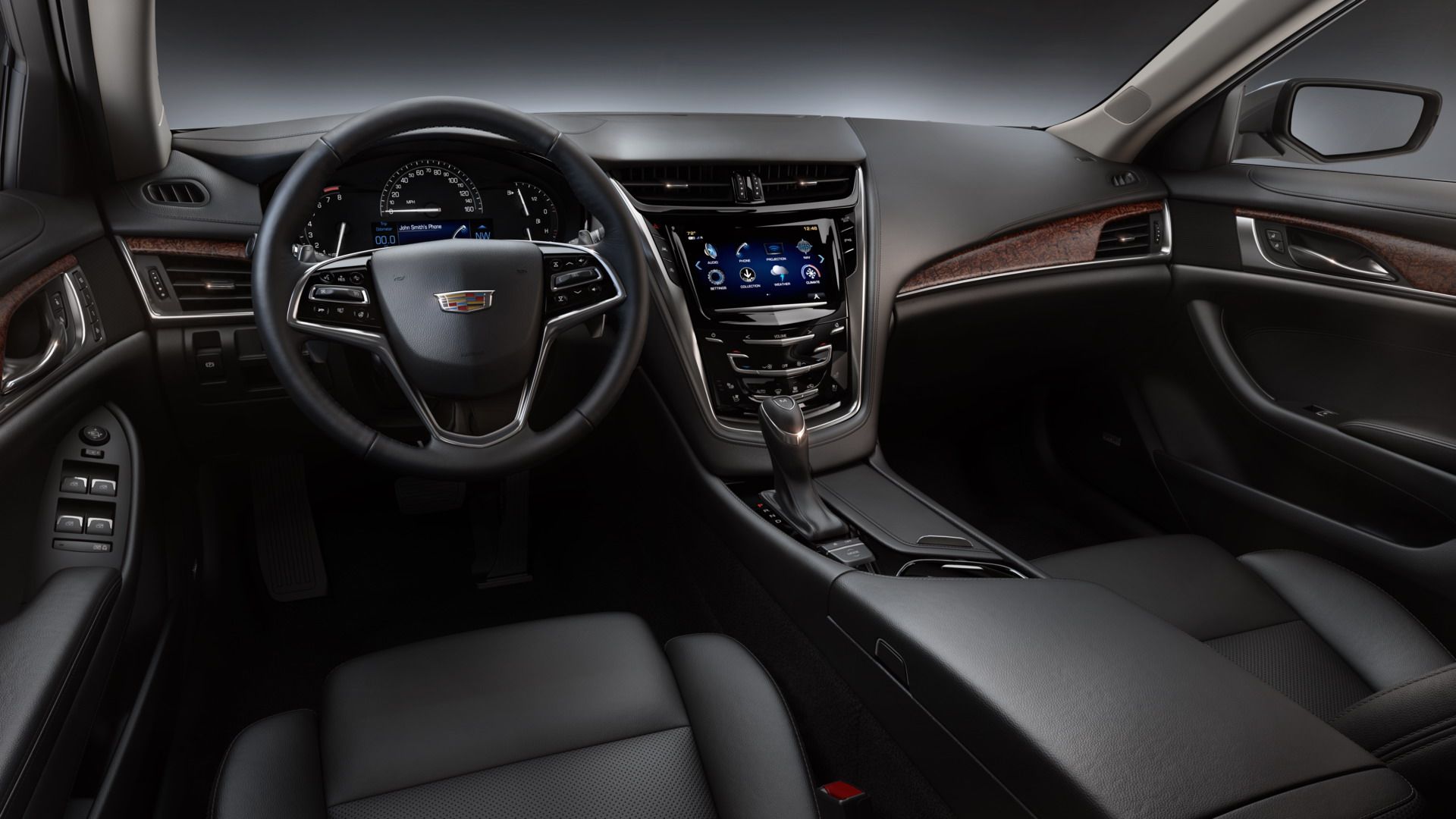
|
Jet Black with Jet Black Accents, Leather seating surfaces |
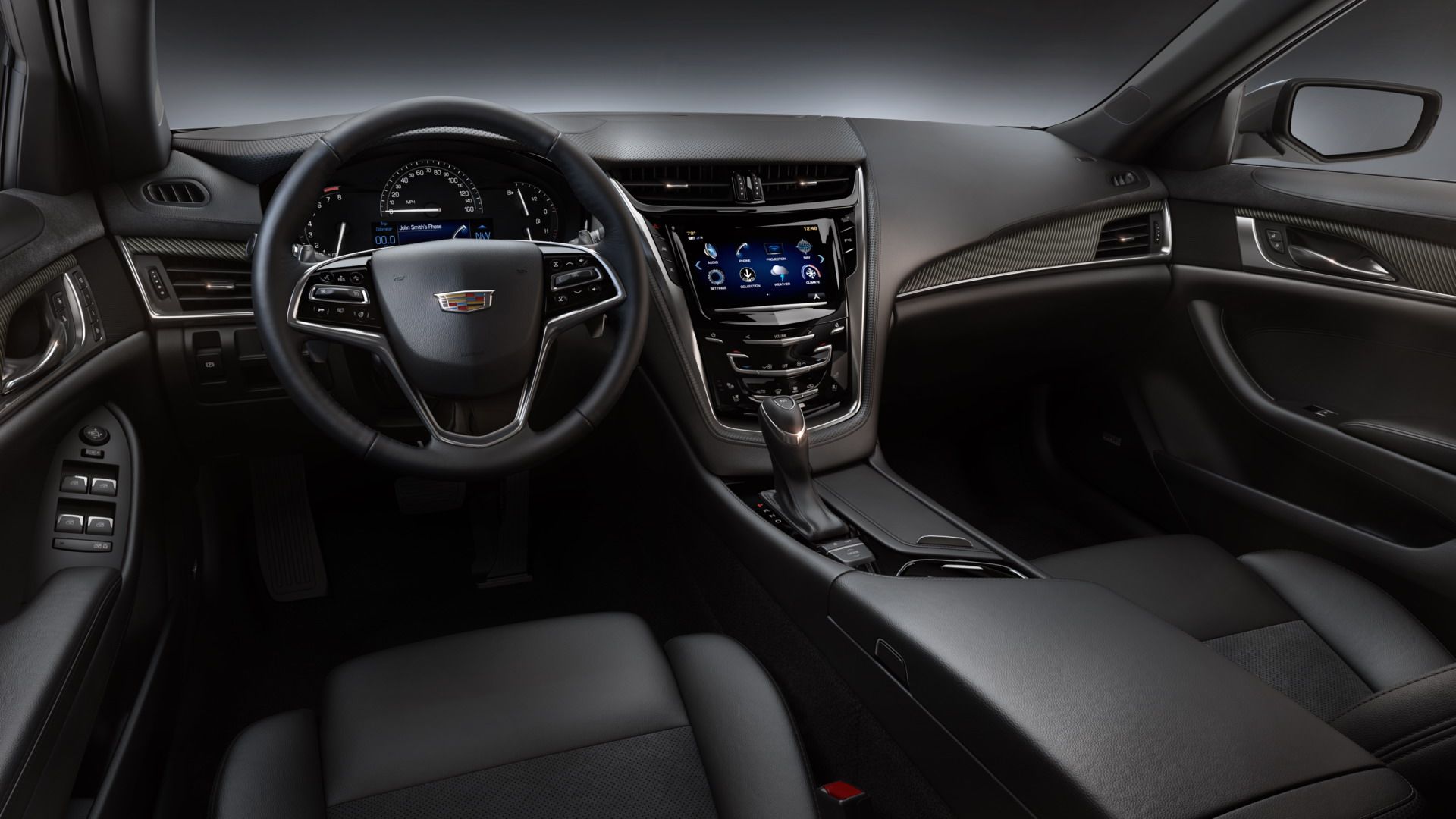
|
Jet Black with Jet Black Accents, Semi-aniline leather seats |
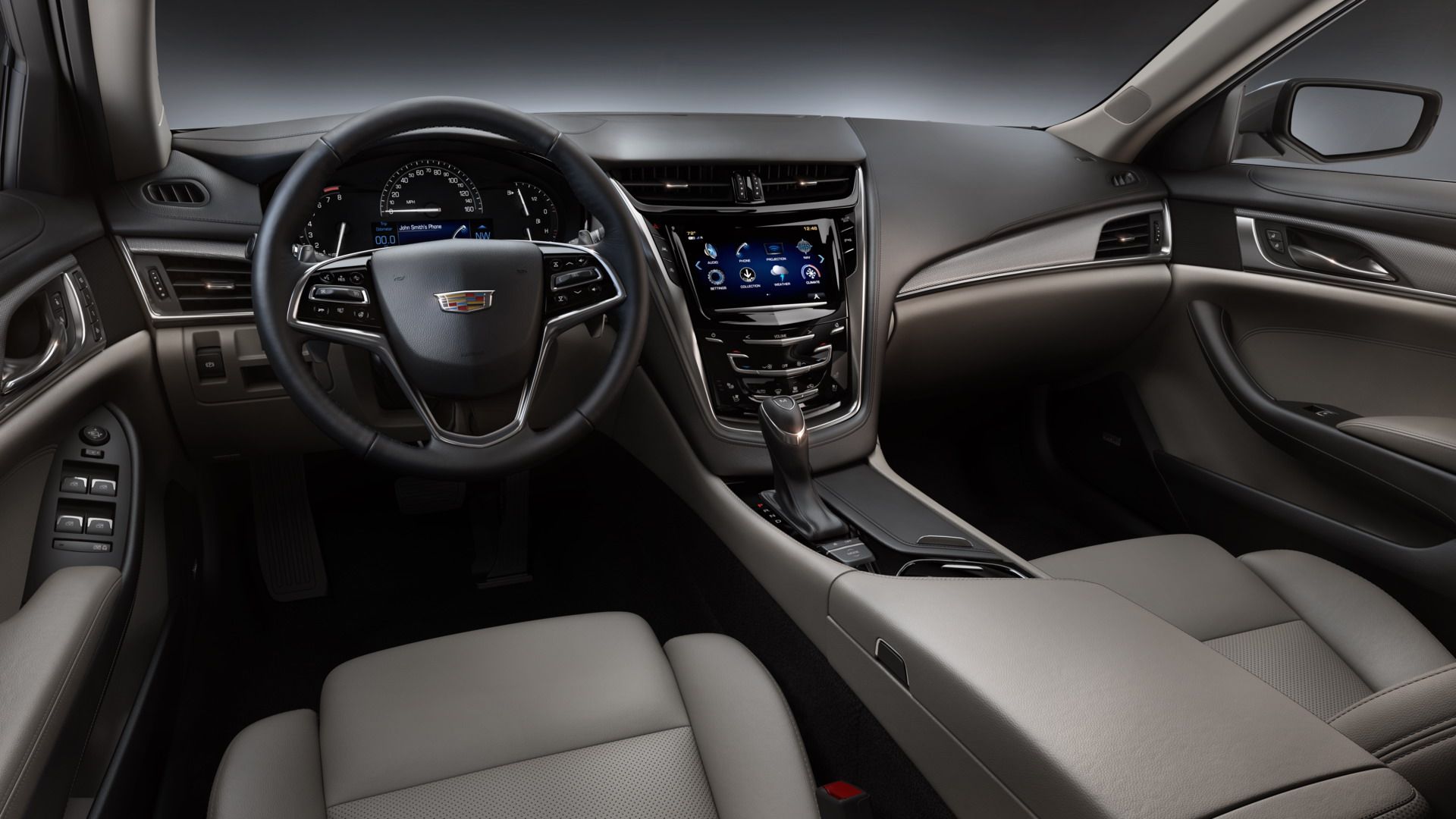
|
Light Platinum with Jet Black Accents, Leather seating surfaces |
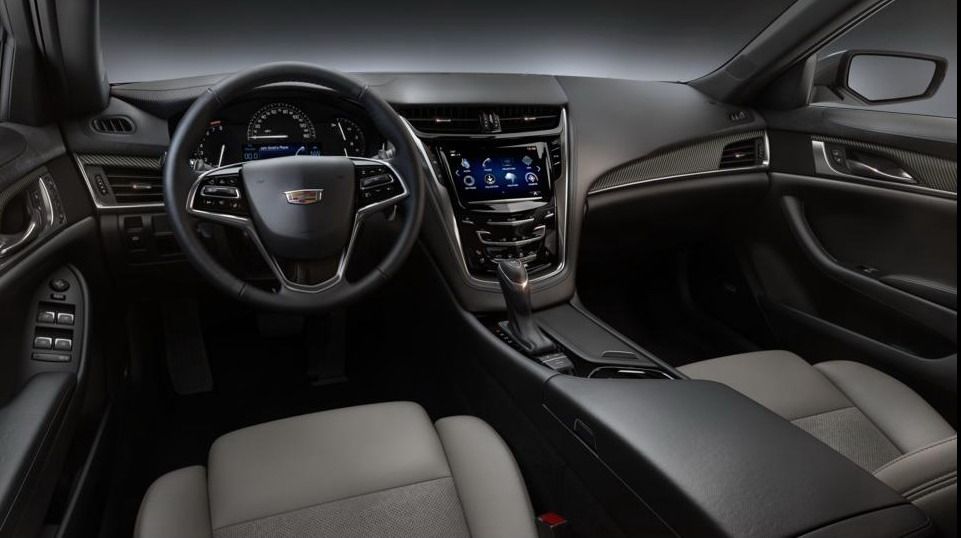
|
Light Platinum with Jet Black Accents, Semi-aniline leather seats |
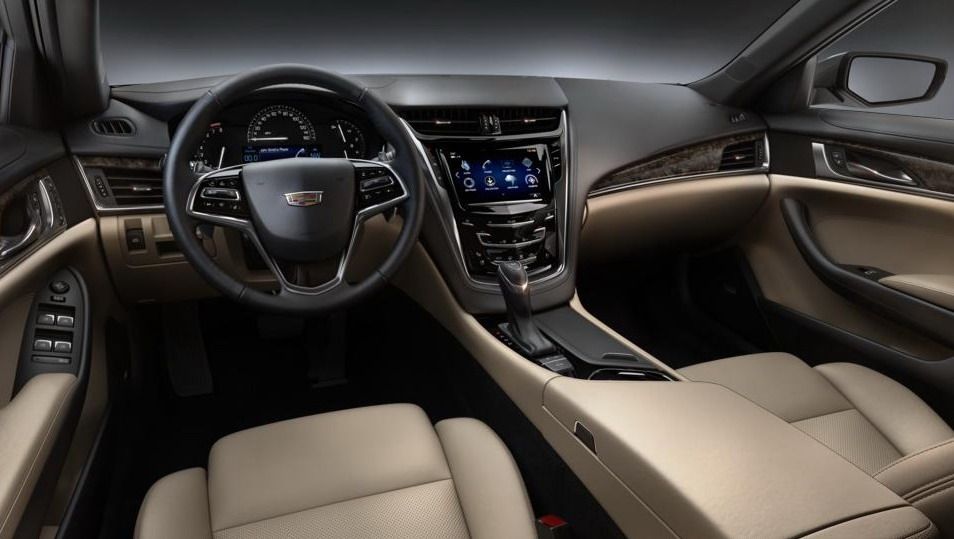
|
Very Light Cashmere with Jet Black Accents, Leather seating surfaces |
When it comes to seat upholstery, there’s of course leather, with the option for a full semi-aniline material that’s handcrafted, cut and sewn. Standard appointment includes 14-way power adjustable seating, with manual cushion length extensions and four-way manual headrests. There’s also 20-way adjustability as an available option, not to mention heating and ventilation as standard when going for upscale leather. Rear heated seats are also available, as is front seat ventilation and a leather-wrapped and heated steering wheel.
As is tradition with any premium segment refresh, the infotainment in the CTS got a few extra bits and bobbles, mostly centered on enhancing “connectivity.” Running it all is the Cadillac CUE system, a platform that’s drawn a significant amount of criticism over the years due to its messy user interface and confusing control layout.
Thankfully, Cadillac has been busy improving this system, and the 2017 CTS gets the latest updates and upgrades in that regard. First up is support for Apple CarPlay and Android Auto for seamless smartphone integration. Users can access Apple CarPlay and Android Auto via a single icon, offering features like navigation, hands-free texting, music, calls, and much more.
Complementing the CUE system are upgrades like the myCadillac Mobile App, Teen Driver feature, and the Cadillac Collection. The Cadillac Collection is a suite of in-car apps that offer users a variety of personalization options for the infotainment system. It allows you to download a variety of apps for weather forecasts, music, news, and more, and offers smartphone-esque operation without relying on a phone for functionality. This system is also upgradeable.
Then there’s the myCadillac Mobile App, which combines the features of the old myCadillac app with those of the OnStar RemoteLink app. This means you get roadside assistance, a parking location reminder, a digital owner’s manual, and vehicle diagnostics. It’ll also let you remotely control a variety of functions from your phone, including the Wi-Fi hotspot, engine start and stop, climate control, and locking/unlocking of the doors. The myCadillac Mobile App is offered for free for five years in the U.S. and Canada.
Speaking of a web connection, the CTS is offered with an optional OnStar 4G LTE Wi-Fi hotspot, which throws in a complimentary three-month/3 GB data plan to try it out. Wireless inductive phone charging is a standard feature.
To help you keep tabs on all this equipment (not to mention all the usual car parameters, like road speed, current selected gear, etc.), Caddy is offering an optional colors heads-up display, as well as a 12.3-inch HD gauge cluster with a reprogrammable functionality. There’s also an 8.0-inch LCD touch screen mounted to the top of the instrument panel. This also offers smartphone-esque display characteristics and operation, with large, singular icons. Further features include partial name recognition, while it’s also used for the Advanced Park Assist display, and to display the Wi-Fi signal strength. There’s also Text Message Alerts, and Siri Eyes Free support, or alternatively, voice control that’s activated by a button located on the steering wheel.
As far as sound goes, the CTS is equipped with a standard 11-speaker audio system from Bose. If you want higher quality sound, there’s also an optional premium 13-speaker stereo, also from Bose, that includes the Centerpoint 2.0 surround sound technology, and the Bose Auto Pilot feature that will “monitor ambient sounds” and adjust the volume and music content appropriately, thus making for a better overall listening experience.
Funny enough, the CTS also gets “electronic sound enhancement,” which basically mean the stereo will amplify your exhaust note for a sportier sound inside the cabin. It should be noted that the stereo won’t be playing a recorded exhaust note, but rather it’s pumping up what’s actually being emitted from the exhaust pipes.
Adding a nice ambience is available LED lighting, which is added to the instrument panel, door panels, foot wells, door map pockets, and other storage areas, and includes an illuminated Cadillac logo.
Other interesting features include a motorized cup holder located in the center console, as well as an electrically actuated glove box with a locking mechanism and internal LED lighting. The glove box is equipped with dual storage levels, and additional storage compartments can be found in the center console, doors, behind the center console controls, and underneath the center armrest. Lift the central armrest, and you’ll also find power ports, an auxiliary jack, and a few USB ports.
There’s also an optional tri-zone climate control system, which mounts vents in the rear console for better temperature regulation if you’re seated in the rear. Manual rear door shades and a power rear window shade also make the options list.
Cadillac is proud of its optional rear camera mirror, a feature it touts as a “segment-exclusive” feature. Basically, it’s a full-display application of the rear-view camera, because why use mirrors if you don’t have to? Standard equipment includes a basic rear vision camera.
If you decide to go for the optional Carbon Black package, the interior will come decked out in low-gloss carbon fiber trim, as well as new performance seating up front. There’s also the option to get into available Recaro front seats, which come as standard on the V-Sport Premium model.
Interior Dimensions
|
Front head room: |
40.4 inches |
|
Front hip room: |
53.8 inches |
|
Front leg room: |
45.7 inches |
|
Front shoulder room: |
56.9 inches |
|
Rear head room: |
37.5 inches |
|
Rear hip room: |
53.3 inches |
|
Rear leg room: |
35.4 inches |
|
Rear shoulder room: |
54.8 inches |
|
Seating capacity: |
5 |
The Competition
Mercedes-Benz E-Class pictured on the left, BMW 5 Series pictured on the right.
I’ll be frank – the Mercedes E-Class interior is a truly wonderful place to be. There’s a polished, streamlined look to it all, with undulating, curved surfaces that flow around the passenger space in unbroken lines, enhancing a natural sense of width. What strikes me the most is the smoothness of it all – nothing really breaks out from the overall design, but rather, each of the elements work together to create a comfortable space. Broad rectangular shapes are used for the surrounds and controls, while rounded shapes are used for the speakers and climate control vents.
In terms of interior features, the E-Class offers well-sculpted front seats with nicely bolstered lateral supports, a standard 12.3-inch HD color digital driver’s information display behind the steering wheel, standard natural grain brown ash wood trim, optional wood trim like black ash, piano lacquer, and walnut, an optional panoramic roof, a wood and leather steering wheel, standard LED interior lighting with 64 different colors, keyless start, optional massage feature, an optional cabin air purification system, optional heated and ventilated front seats, an optional heated steering wheel, Nappa leather upholstery, a standard 12.3-inch HD central display, an under-dash subwoofer, voice control, Bluetooth, two USB ports, a heads-up display, optional wireless phone charging, and an optional Burmester sound system.
By comparison, the BMW 5 Series interior is a bit more angular and techy. The look and layout is definitely more asymmetrical and driver-oriented than the Caddy, with both the center console and the dash-mounted infotainment screen angled towards the driver’s seat. There’s a definite sense of vertical layers to the Bimmer, with high-end materials and premium touches throughout. The predominate shapes used are rectangular, which matches up well with the BMW’s exterior styling.
Interior features for the BMW 5 Series include 20-way power adjustable front seats, power adjustable head rests, Dark Wood trim, Dakota leather upholstery, a surround sound audio system from Harman Kardon with an equalizing feature and 16 speakers, SiriusXM radio with a complimentary 1-year subscription, a leather-wrapped multi-function steering wheel, USB inputs, Bluetooth, an LCD instrument cluster display, a rear-view camera, a 10.2-inch high-resolution infotainment screen, 200 GB onboard hard drive, the BMW iDrive system with a touchpad controller, keyless entry and remote control functions, a moonroof, ambient lighting, an auxiliary input in the front armrest, and dual cup holders in the front and back.
Based on the technology, look, and layout of all three of these interiors, I would choose the Mercedes E-Class as my go-to favorite. Unlike the more traditional CTS and the chunky BMW, the Mercedes just feels and looks slicker. It’s got gloss in all the right places, plus soft touch surface everywhere else, and to my eye, it more powerfully asserts its position as a luxury chariot.
The Competition
|
Mercedes-Benz E-Class pictured on the left, BMW 5 Series pictured on the right.} |
Mercedes-Benz E-Class |
|
|
Front head room: |
37.4 inches |
38.8 inches |
|
Front leg room: |
41.7 inches |
41.4 inches |
|
Front shoulder room: |
57.8 inches |
58.7 inches |
|
Rear head room: |
38.2 inches |
37.5 inches |
|
Rear leg room: |
36.2 inches |
36.5 inches |
|
Rear shoulder room: |
57.1 inches |
55.9 inches |
|
BMW 5 Series |
5 |
5 |
Drivetrain
Cadillac is offering three separate engine choices for the CTS sedan. Each powerplant comes with all-aluminum construction, direct fuel injection, and variable valve timing. Paired with each engine is an eight-speed automatic transmission with paddle-style shifters, although depending on which engine you choose, there are two different eight-speeds on offer.
Starting things off is the base model CTS, which gets a 2.0-liter turbocharged four-cylinder that produces 268 horsepower and 295 pound-feet of torque. That’s a decent wallop from a 2.0-liter, throwing down as much as 134 ponies per liter, making for what Cadillac claims to be one of the most “power-dense engines in the industry.” Also of note is the 2.0-liter’s torque curve, with at least90 percent of peak twist created between 2,100 and 5,400 rpm, while all 295 pound-feet is made between 3,000 and 4,500 rpm. Helping to produce all that output is up to 1.26 bar (18 psi) of boost pressure.
Up next is a naturally aspirated 3.6-liter V-6, which makes 335 all-atmosphere ponies and 285 pound-feet of torque. This engine also provides Cadillac with an opportunity to boast, as it is apparently the most powerful naturally aspirated V-6 engine in the segment.
Finally, we have the CTS V-Sport, the last stop before you get to the top of the line CTS-V “super sedan.” Essentially a sportier CTS (but not outrageously so like the CTS-V), the V-Sport comes outfitted with a boosted V-6 engine that produces 420 horsepower and 430 pound-feet of torque. The CTS V-Sport is only offered with RWD. All that output is courtesy of two small turbos plugged into an intercooler, which stuff the six-cylinder with enough air to fatten the torque curve with 90 percent of the peak torque made between 2,500 and 5,500 rpm. The 0-to-60 mph sprint for this one is rated at 4.4 seconds, while top speed is around 170 mph.
Once again, Cadillac finds reason to boast, saying the V-Sport offers the most power-dense six-cylinder engine in the mid-size segment. If you feel the need to show off this high-performance capability with some apex hunting, don’t forget to opt into the uprated track cooling package.
Finally, acting as the tip of the spear is the Cadillac CTS-V. Under this machine’s muscular hoodline is a thumping 6.2-liter V-8 engine, which is supercharged to a staggering 640 horsepower and 630 pound-feet of torque, making it the most powerful production Cadillac in the brand’s history.
If something like that is a little closer to your speed, go ahead and check it out in-depth in our review here.
If fuel economy is a concern, then it’s worth mentioning that both the 2.0-liter turbo four-cylinder and the naturally aspirated 3.6-liter V-6 are equipped with start/stop systems that will cut the engine when idling at a stop sign, red light, or in heavy traffic, then kick it back over when you set off again. Additionally, that naturally aspirated V-6 is also equipped with a cylinder deactivation system and Active Fuel Management, which essentially turns it into a four-banger when you’re cruising and don’t need full power.
As for the two eight-speed automatic transmissions – the 2.0-liter turbo four and naturally aspirated V-6 get the same unit, while the hotter twin-turbo CTS V-Sport receives a “higher-capacity” transmission unit. It should be noted that the eight-speed transmissions are a replacement for the old six-speed automatic unit, which was ditched for the 2016 model year. These new gearboxes get Gen II control system for more immediate feel and response, as well as lower shift times. Technical highlights include variable force solenoid technology and three internal speed sensors. Both use synthetic gear oil, and there is a specific torque converter design for each transmission.
To help pad the fuel economy and trim the emissions, the CTS models below the V-Sport and CTS-V use an overall gearing ratio of 7.0:1, plus a lower top gear for 5 percent better fuel economy when compared to the old six-speed automatic. The transmission also has four gear sets and five clutches, including three rotating clutches and two brake clutches. Interestingly, the eight-speed manages to fit in the same space as the outgoing six-speed automatic, and offers a lower weight as well.
All models come equipped with RWD as standard, but the 2.0-liter turbo base model and naturally aspirated 3.6-liter V-6 mid-range model are both offered with optional AWD paired with automatic wheel-slip management technology.
|
2.0L Turbo DI VVT |
3.6L V-6 DI VVT |
Twin-Turbo 3.6L DI VVT |
|
|
Displacement (cu in / cc) |
122 / 1998 |
223 / 3649 |
217 / 3564 |
|
Bore & stroke (in / mm) |
3.39 x 3.39 / 86 x 86 |
3.74 x 3.37 / 95 x 85.8 |
3.70 x 3.37 / 94 x 85.6 |
|
Horsepower |
268 HP @ 5,600 RPM |
335 HP @ 6,800 RPM |
420 HP @ 5,750 RPM |
|
Torque |
295 LB-FT @ 3,000-4,500 RPM |
285 LB-FT @ 5,300 RPM |
430 LB-FT @ 3,500-4,500 RPM |
|
Transmission |
Hydra-Matic 8L45 paddle-shift eight-speed |
Hydra-Matic 8L45 paddle-shift eight-speed |
eight-speed, electronically controlled |
|
Curb weight |
3,652 Lbs |
3,757 Lbs |
3,924 Lbs |
|
Fuel economy (city / hwy) |
21/30 |
20/30 |
16/24 |
The Competition
Mercedes-Benz E-Class pictured on the left, BMW 5 Series pictured on the right.
There are three levels to choose from when opting into the E-Class. The first is the base model E300, which is equipped with a turbocharged 2.0-liter inline four-cylinder that produces 241 horsepower at 5,500 rpm and 273 pound-feet of torque between 1,300 and 4,000 rpm. The engine features all-aluminum construction, direct fuel injection, and variable valve timing. The only transmission choice is a 9G-Tronic nine-speed automatic, with RWD as standard.
Up next is the E300 4Matic, which is essentially the same set-up as the E300, including the 241-horsepower four-cylinder engine and nine-speed automatic gearbox, but instead of RWD, the 4Matic adds AWD.
Finally, at the head of the class is the AMG E43, which is equipped with a twin-turbo 3.0-liter V-6 that lays down as much as 396 horsepower at 6,100 rpm and 384 pound-feet of torque between 2,500 and 5,000 rpm. This powerplant also uses all-aluminum construction, and is mated to a 9G-Tronic nine-speed automatic transmission as standard. Making the traction is a performance-tuned 4Matic AWD system. Properly motivated, the can hit 60 mph in 4.5 seconds.
Up next is the 5 Series, which arrives with five different powertrain options on the table, starting with the turbocharged four-cylinder of the base model 528i. This engine produces 240 horsepower, plus 260 pound-feet of torque between 1,250 and 4,800 rpm. Technical features include direct fuel injection and BMW’s Double-Vanos variable valve system. Following the 528i is the 535i, which adds two cylinders for an inline-six configuration. Displacement comes is at 3.0-liters, while a turbo helps to boost output to 300 horsepower and 300 pound-feet total.
The 550i and its 4.4-liter turbocharged V-8 heads the gasoline lineup, using its double dose of boost makers to create 445 horsepower and 480 pound-feet of torque – enough to propel the four-door to 60 mph in just 4.3 seconds.
If you prefer a diesel, BMW has you covered there as well with the 535d sedan, which employs a 3.0-liter inline six-cylinder to produce up to 255 horsepower and 413 pound-feet of torque.
Each BMW engine is mated to a RWD drivetrain as standard, plus the option for AWD. Making the cog swaps is an eight-speed Steptronic transmission.
Choosing between these three isn’t an easy decision. Each marque offers very similar powerplant packages and performance numbers. However, BMW stands out from the rest thanks to its large selection of engine options, including four-, six-, and eight-cylinder configurations. There’s even a diesel. And topping it off is the impressive 550i, which leads the pack with the most power and the quickest 0-to-60 mph time.
|
Mercedes-Benz E-Class pictured on the left, BMW 5 Series pictured on the right.} |
|||||||||||
|
Mercedes E300 |
Mercedes E400 |
BMW 528i |
BMW 535i |
BMW 550i |
BMW 535d |
2.0-liter turbocharged inline four-cylinder |
3.0-liter twin-turbo V-6 |
2.0-liter turbocharged four-cylinder |
3.0-liter turbocharged inline six-cylinder |
4.4-liter twin-turbo V-8 |
3.0-liter turbocharged diesel |
|
Horsepower |
241 HP @ 5,500 RPM |
396 HP @ 6,100 RPM |
240 HP @ 5,000 RPM |
300 HP @ 5,800 RPM |
445 HP @ 5,500 RPM |
255 HP @ 4,000 RPM |
|||||
|
Engine |
273 LB-FT @ 1,300 RPM |
384 LB-FT @ 2,500-5,000 RPM |
260 LB-FT @ 1,250-4,800 RPM |
300 LB-FT @ 1,200 RPM |
480 LB-FT @ 1,750 RPM |
413 LB-FT @ 1,500 RPM |
|||||
|
Horsepower |
RWD or AWD |
AWD |
RWD or AWD |
RWD or AWD |
RWD or AWD |
RWD or AWD |
|||||
|
Transmission |
nine-speed automatic |
nine-speed automatic |
eight-speed automatic |
eight-speed automatic |
eight-speed automatic |
eight-speed automatic |
|||||
|
Torque |
22/30/25 |
18/25/- |
23/34/27 |
20/30/23 |
17/25/20 |
26/38/30 |
|||||
|
Curb weight |
3,792 Lbs |
4,145 Lbs |
3,814 Lbs |
4,090 Lbs |
4,365 Lbs |
4,085 Lbs |
4,085 Lbs |
Chassis And Handling
Underneath the body panels, you’ll find GM’s Alpha platform. Alpha is used to underpin several different compact to mid-size vehicles, providing the bones for a front-mounted engine, and either a RWD or AWD drivetrain layout. Both coupes and sedans are listed for the body style.
The Alpha platform was first introduced in 2012 for the 2013 model year Cadillac ATS compact. A year later, it was used to underpin the 2014 CTS. It should be noted that the Alpha architecture is also used for the 2016 and above Chevrolet Camaro.
When designing a sporty luxury car, one of the biggest enemies is the inevitably high curb weight. And that can be a problem when you consider the importance of luxury items like sound deadening, infotainment equipment, high-end upholstery, and premium trim, all of which add substantial heft. And yes, and I’m also putting “carbon fiber” console covers in that list.
The Alpha platform attempts to reduce weight through the inclusion of high-strength steel and aluminum. The wheels are made from aluminum as well. A good amount of aluminum was also used for the suspension components, although Cadillac says the rear suspension is composed of “mostly steel,” which apparently helps to balance out the front/rear weight balance. Given the burden placed on the front axle by the transmission and engine, it’s interesting Cadillac opted to use steel in back to achieve the CTS’ “near-perfect” 50/50 ratio. After all, a 50/50 ratio is obviously good for handling, and it reduces NVH as well, but if it means cutting down on production costs a little by using steel instead of aluminum, it seems like a win-win.
Speaking of the suspension, the CTS uses a multi-link MacPherson strut set-up in front with a double-pivot design, while the rear suspension is composed of an independent five-link. Options include a Magnetic Ride Control system with real-time damping adaptability, just like the Chevy Corvette and Camaro ZL1.
That means it should handle quite nicely, especially since Cadillac went to the effort to develop the handling package and that most-famous of German racetracks, the Nurburgring. This is where the Caddy’s chief rivals are tested as well, so it makes sense to iron out any handling bugs on the Ring’s 13 miles of challenging twists and elevation changes. Supposedly, this testing has resulted in better feedback, control, and response.
Complementing the handling are four-wheel disc brakes, with the front stoppers sourced from Brembo. The steering is electrically boosted, and includes a variable amount of assist courtesy of ZF Steering Systems.
Given its high-end engine package, it should come as no surprise the CTS V-Sport is the sportiest option on the table, at least until you get to the rip-snortin’ CTS-V, that is. Standard equipment includes 18-inch wheels wrapped in Pirelli summer performance rubber and an extra inch of tire width (275/35R18), a sportier suspension system with new spring rates and stabilizer bars, a quicker steering ratio with appropriately sporty tuning and response, race calibrations for the throttle response and Magnetic Ride Control settings, and an electronic limited-slip differential for more traction when powering off a corner.
The Competition
Mercedes-Benz E-Class pictured on the left, BMW 5 Series pictured on the right.
The Mercedes-Benz E-Class offers both sportiness and comfortable luxury, with either characteristic enhanced by whatever options or trim level you go for. Starting it off are multiple driving modes, selectable from the driver’s seat, with settings including Eco, Comfort, Sport, Sport+, and the personalized Individual mode. These affect the throttle response, transmission settings, and suspension settings in a self-evident fashion. Keeping it planted is a four-wheel independent suspension system with a four-link set-up in front and a five-link set-up in the rear. The hard bits use forged aluminum for the construction, and also toss in automatically adjusting dampers. Steering it is an electromechanical power set-up. Optional comfort suspension is also offered if sportiness isn’t on your mind, as is optional adaptive air suspension. If you prefer speed, there are optional sport brakes for the front wheels. Finally, the underlying platform is made from aluminum and steel.
The BMW 5 Series is also ripe for either sportiness or luxury, and also offers multiple driving modes to customize your ride preferences. The construction finds a lower curb weight thanks to the inclusion of lots of aluminum. There’s Dynamic Damper Control to soak up the bumps, while Active Steering comes into play with four-wheel adjustments for either low speed sprightliness or high-speed stability.
In terms of handling, I’m partial to the Bimmer. While BMW has arguably gotten a bit muddled over the years following its reign as the “Ultimate Driving Machine,” the 5 Series is still a lively and exciting vehicle to pilot. Coupled with copious high-performance options (brakes, suspension, tires, etc.), plus available RWD on each trim level, and the BMW is what you want if driving excitement is what you’re after.
Mercedes-Benz E-Class pictured on the left, BMW 5 Series pictured on the right.0}
When it comes to electronic nannies and helpers, the Cadillac is equipped with GM’s ubiquitous OnStar program, and customers can get the OnStar Basic plan with five years of connectivity at no cost upon purchase. This throws in the OnStar Vehicle Diagnostics program, which will electronically monitor various vehicle systems for failures or needed repairs, and if the car needs service, it’ll send a Dealer Maintenance Notification that attaches a diagnostic readout to a local dealership. There’s also OnStar Smart Driver, which will monitor how you drive and offer you chances to save on car insurance. AtYourService is also included, which offers drivers a chance to save money at local participating merchants.
Upon purchase, customers get six months of the OnStar Guidance system, which offers turn-by-turn navigation. It also offers the OnStar security and safety system, with features like Automatic Crash Response and Stolen Vehicle Assistance.
Further safety and convenience features are wrapped up with the Driver Awareness and Driver Assist Packages. The included systems add technology like radar, supplementary visual cameras, and ultrasonic sensors to expand the car’s ability to predict dangerous situations and help the driver with difficult maneuvers.
A few of these features include upgraded driver vision, which will highlight road hazards and assist as appropriate. There’s also front and rear automatic braking, which can detect imminent collisions and apply the binders, whether you’re moving forward or reversing.
More specifically, the Driver Awareness package adds the Safety Alert Seat, Side Blind Zone Alert, Lane Change Alert, Lane Keep Assist, Lane Departure Warning, Forward Collision Alert, Rear Cross Traffic Alert, high-beam assist, and rain-sensing windshield wipers.
Higher up in the range is the Driver Assist package, which gets all the same stuff as the Driver Awareness package, but also adds full-speed range-adaptive cruise control, automatic safety belt tightening, and the previously mentioned front and rear automatic braking.
Ultrasonic Rear Park Assist is equipped as standard equipment, but you can upgrade to the full Automatic Parking Assist (both parallel and rear parking) if desired. Basically, this system will handle all the steering during tight-space maneuvers, and all you gotta do is apply the throttle and brakes when prompted.
Rounding it out is the usual standard airbag system (10 airbags total), seatbelt pretensioners with load limiters, a Rear Vision Camera for reversing, Caddy’s StabiliTrak electronic stability control, traction control, four-channel ABS, and automatic-dry brake functionality.
The Competition
The Mercedes E-Class comes with a large variety of features to stay on the technological cutting edge of safety and convenience. One unique system is Pre-Safe, which will emit a noise to trigger your ear’s natural defense mechanism in a crash, protecting your hearing. There’s also a system that will physically move you away in the cabin from the point of impact in the event of a crash. Standard equipment includes a car-to-X communication system for warnings and messages, although this system is limited until more cars and roadways feature this technology. Crosswind assist, rain-sensing windshield wipers, adaptive cruise control, lane keep assist, evasive steering assist, blind spot warning, lane change assist, parking assist, speed limit monitor, and nine airbags finish the list.
The BMW 5 series offers very similar features to both the Mercedes and Cadillac. Go for the Driver Assistance Plus package, and you’ll enjoy equipment like adaptive cruise control with a stop and go feature, plus active blind spot monitoring and a lane keep assist. There’s also a side and top view camera. Additionally, customers can get the BMW Assist system, which is thrown in with the optional Convenience plan, and adds features like traffic information, weather forecasts, a concierge service, and more.
In terms of technology, I think the Mercedes has the upper hand here. While standard equipment might be a bit lacking, you can get a whole lot of safety and convenience features if you’re bold with the options list.
Safety And Convenience
New for the 2017 model year is the Cadillac CTS’ revamped naming conventions, which apparently “streamlines” the trim levels into five basic offerings. This helps the CTS more accurately reflect changes elsewhere in the Cadillac lineup, as seen with the CT6 sedan, and XT5 crossover.
Starting things off is the base model CTS, starting at $46,990. Next is the Luxury at $52,690 for models equipped with a 2.0-liter engine, and $54,690 for models equipped with the naturally aspirated 3.6-liter V-6. The Premium Luxury model follows with the same NA 3.6-liter V-6, starting at $60,190, with the performance-oriented V-sport leading with its twin-turbo six-cylinder at $61,690. You can also get the top-of-the-line V-Sport Premium Luxury for $71,790 if you want it all.
The Carbon Black Package, which adds those dark-themed exterior enhancements and interior upgrades, is only offered on the CTS Luxury, CTS V-Sport, and CTS V-Sport Premium trim levels. Meanwhile, the Driver Awareness package is offered on the Luxury and Premium Luxury trim levels, and comes as standard on the V-Sport Premium Luxury.
|
Cadillac CTS base model |
$46,990 |
|
Cadillac CTS Luxury (2.0-liter turbo four-cylinder engine) |
$52,690 |
|
Cadillac CTS Luxury (3.6-liter NA V-6 engine) |
$54,690 |
|
Cadillac CTS Premium Luxury (3.6-liter NA engine) |
$60,190 |
|
Cadillac CTS V-Sport (3.6-liter twin-turbo V-6 engine) |
$61,690 |
|
Cadillac CTS V-Sport Premium Luxury (3.6-liter twin-turbo V-6 engine) |
$71,790 |
The Competition
There are three trim levels of the Mercedes-Benz E-Class sedan to choose from. The base model is the E300, which is equipped with a 2.0-liter turbocharged four-cylinder and RWD, starting at $52,150. Next is the E300 4Matic, which is also equipped with a 2.0-liter turbocharged four-cylinder, but gets 4Matic AWD rather than RWD, and starts at $54,650. Finally, we have the AMG E 43, which gets a twin-turbo 3.0-liter V-6 and AWD, starting at $72,400.
Back in the BMW camp, the 5 Series sedan kicks off with the 528i and its 2.0-liter turbocharged four-cylinder. Get it with RWD for $50,200, or AWD for $52,500. Next is the 535i sedan and the 3.0-liter turbo inline six-cylinder, which starts at $55,850 for RWD and $58,150 for AWD. The V-8-powered 550i starts at $66,300 for RWD and $68,600 for AWD, while the diesel-powered 535d is $57,350 for RWD.
|
Mercedes E300 |
$52,150 |
|
|
Mercedes E300 4Matic |
$54,650 |
|
|
Mercedes-AMG E43 |
$72,400 |
|
|
BMW 528i |
$52,500 |
|
|
BMW 535i RWD |
$55,850 |
|
|
BMW 535i AWD |
$58,150 |
|
|
BMW 550i RWD |
$66,300 |
|
|
BMW 550i AWD |
$68,600 |
|
|
BMW 535d |
$57,350 |
Prices
The Competition
No discussion of top-shelf mid-size luxury sedans would be complete without the final member of the big German three – Audi. In this segment, the Four Rings offers the A6, which currently is in its fourth generation, first released for the 2012 model year. Multiple engines are on offer, including a 2.0-liter TFSI and a 3.0-liter TFSI. Leather upholstery, advanced safety features, and available LED headlights make the features list, as does Audi’s famous quattro AWD system. Pricing starts at $47,600, but can range as high as $67,600 for the sportier Competition model.
Read the full review here.
Jaguar XF
The Brits don’t mind throwing their weight around here as well, with Jaguar offering up the handsome XF sedan. First produced in 2007, the XF just received its second generation in 2015, boasting an exterior design penned by Ian Callum, and also the option for a long wheel base model. The engine lineup consists of a 2.0-liter turbocharged four-cylinder and a supercharged 3.0-liter V-6 in various states of tune. You can also get it with a diesel, if you’re into that kind of thing.
Read the full review here.
Conclusion
The premium sports sedan segment is tough place to be if you’re not from Germany. The big three Teutonic titans of Audi, BMW, and Mercedes pretty much have the whole thing on long down, having enjoyed their preeminent status in this segment for years now.
But that doesn’t mean the CTS doesn’t have what it takes to compete. Put side-by-side with its chief rivals, it’s got the technology, the opulence, and the speed to be a major threat, and although subjective areas like exterior styling and interior layout are a matter of debate, the excellent value you get by going with Cadillac is clear cut.
But this space is more than numbers and what you get for your money – it’s also about perception, and when you’re driving a BMW or Mercedes, that perception is obvious. You do well and you want to show it off. And that means Cadillac needs to polish itself up and get back to where it was – a premium brand filled with high-end choices.
That makes the CTS particularly important. On paper, it has it where it counts. Now we just have to see if customers agree.

